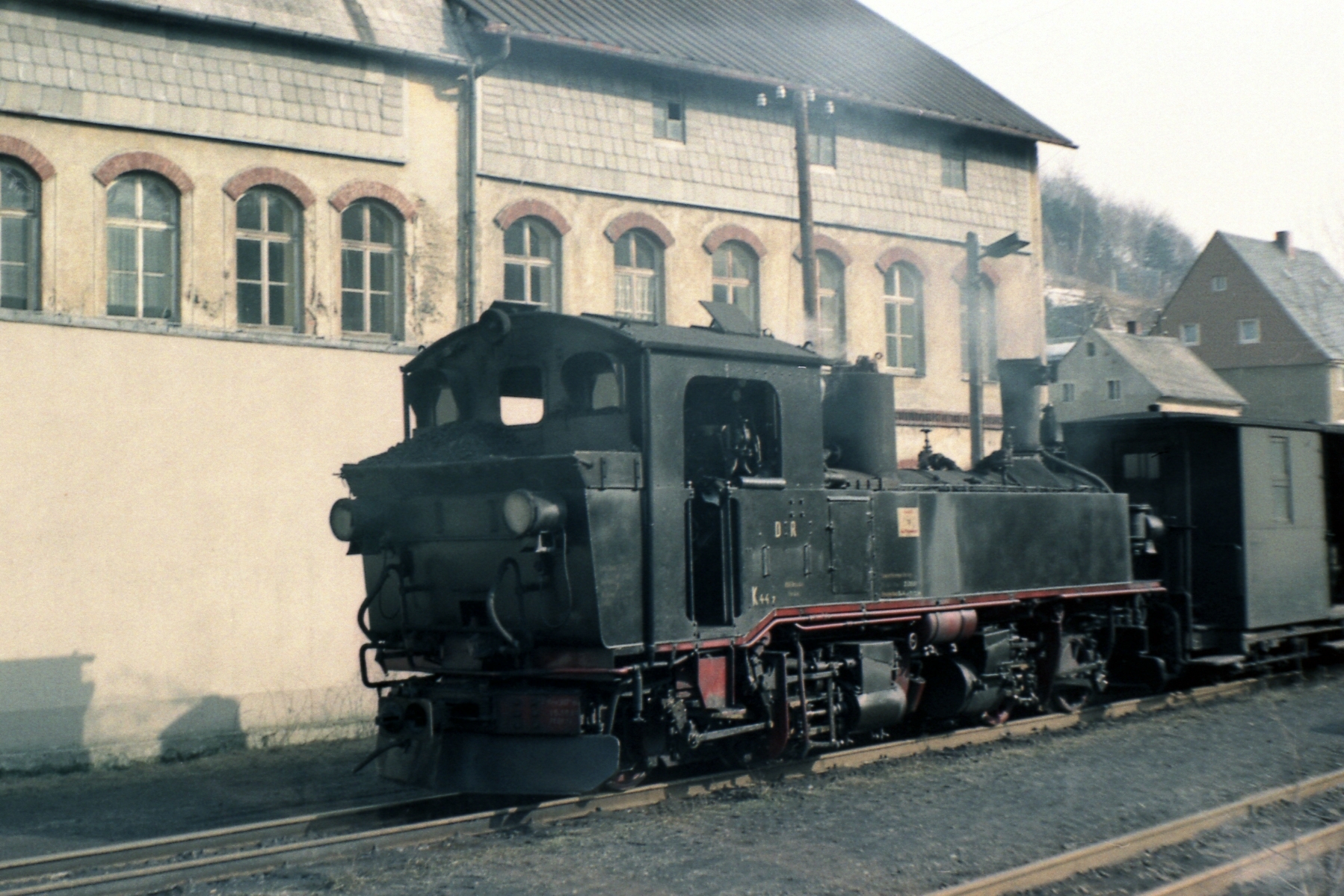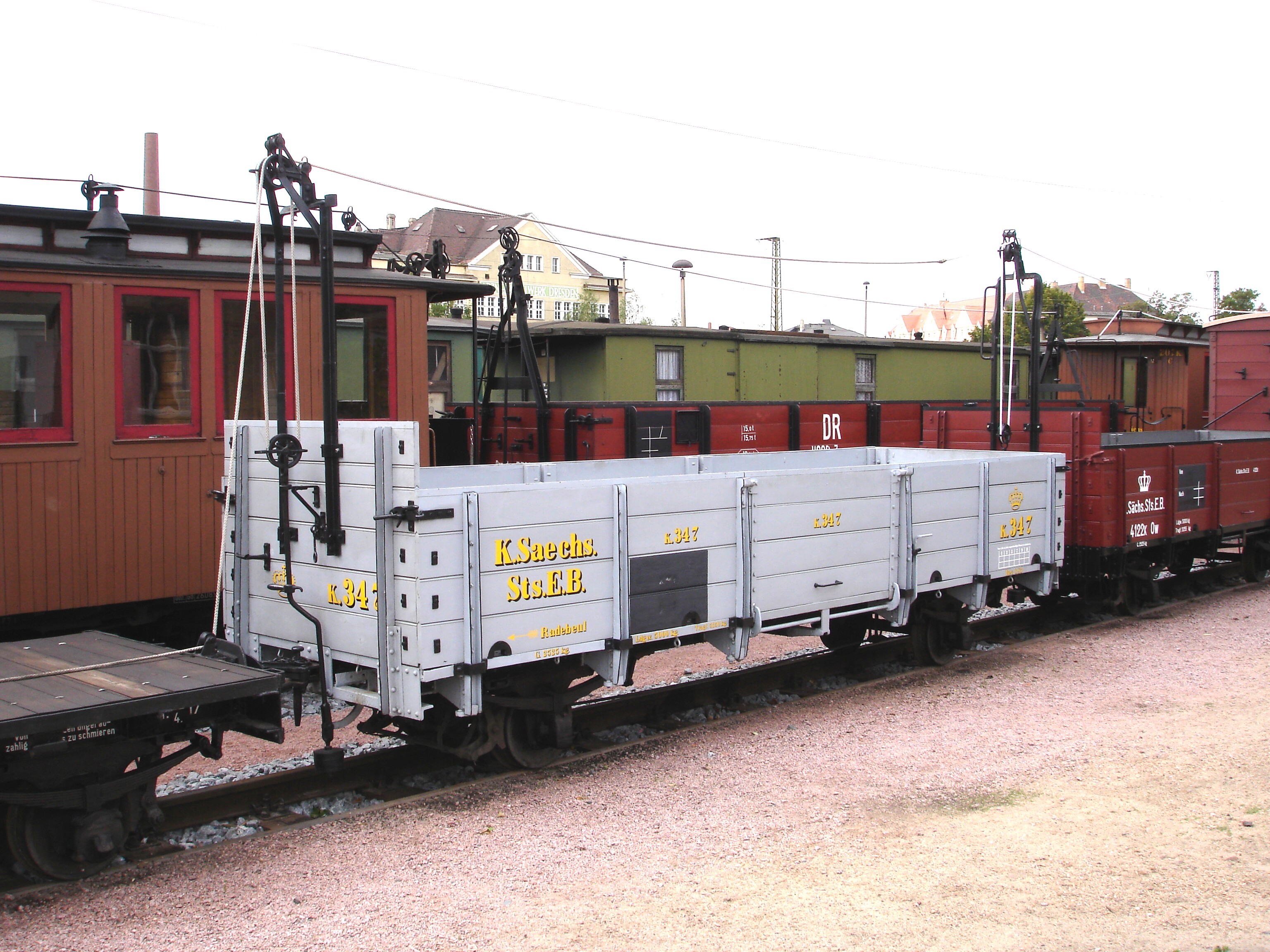|
Saxon V K
The Saxon Class V K were German narrow gauge steam locomotives operated by the Royal Saxon State Railways which had been primarily intended for the '' Müglitztalbahn''. In 1925 the Deutsche Reichsbahn incorporated arranged these locomotives as DRG Class 99.61. History For the hilly line of the ''Müglitztalbahn'' from Mügeln to Geising- Altenberg the Sächsische Maschinenfabrik in Chemnitz developed an eight-coupled locomotive which, it was envisaged, would handle this route better that the hitherto deployed Saxon Classes I K and IV K. In 1901 and from 1905 to 1907 a total of nine locomotives were placed in service. Those built in 1905 had a slightly larger driver's cab. Whilst the new type of drive using Klien-Lindner axles allowed the engines to negotiate tight curves, in the end the new Class V K proved just as complicated and maintenance-intensive as the tried and tested IV K. For that reason no more were procured, despite their better starting characteristics. A ... [...More Info...] [...Related Items...] OR: [Wikipedia] [Google] [Baidu] |
Sächsische Maschinenfabrik
The Sächsische Maschinenfabrik in Chemnitz was one of the most important engineering companies in Saxony in the second half of the 19th century and the first two decades of the 20th century. Including its various predecessor businesses, the firm existed from 1837 until its liquidation in 1930, and individual branches of the company taken over by others continued to operate until 1990. The company is closely linked with the name of its founder and long-time manager, Richard Hartmann, whose name formed part of the new company title in 1898: the ''Sächsische Maschinenfabrik vormals Richard Hartmann'' ('Saxon Engineering Factory, formerly Richard Hartmann'). Major products The main aim of the business was the development, design and production of: * Spinning machines (1837–1998) * Locomotives (1848–1929) * Steam engines * Turbines * Mill equipment * Military technology (about 1910–1918) No less than 4,699 locomotives were built by the company between 1848 and 1929. The maj ... [...More Info...] [...Related Items...] OR: [Wikipedia] [Google] [Baidu] |
Compound Locomotive
A compound locomotive is a steam locomotive which is powered by a compound engine, a type of steam engine where steam is expanded in two or more stages. The locomotive was only one application of compounding. Two and three stages were used in ships, for example. Compounding became popular for railway locomotives from the early 1880s and by the 1890s were becoming common. Large numbers were constructed, mostly two- and four-cylinder compounds, in France, Germany, Austria, Hungary, and the United States. It declined in popularity due to maintenance issues and because superheating provided similar efficiencies at lower cost. Nonetheless, compound Mallets were built by the Norfolk and Western Railway right up to 1952. Introduction In the usual arrangement for a compound engine the steam is first expanded in one or two high-pressure ''(HP)'' cylinders, then having given up some heat and lost some pressure, it exhausts into a larger-volume low-pressure ''(LP)'' cylinder, (or two, - or ... [...More Info...] [...Related Items...] OR: [Wikipedia] [Google] [Baidu] |
Narrow Gauge Railways In Saxony
The narrow-gauge railways in Saxony were once the largest single-operator narrow-gauge railway network in Germany. In Saxony, the network peaked shortly after World War I with over of tracks. At first, it was primarily created to connect the small towns and villages in Saxony – which had formed a viable industry in the 19th century – to already established standard-gauge railways. But even shortly after 1900, some of the railways would become important for tourism in the area. History Beginnings Around 1875, the Royal Saxon State railway network, unlike other states in Germany, had already expanded to cover most of the territory of Saxony. Due to the mountainous terrain, any further expansion was met with a disproportional cost increase. In order to keep costs down, most new track projects were then planned and executed as branch lines, with smaller radii for curves, simpler operating rules and unsupervised stations and yards as the primary means to save costs. However ... [...More Info...] [...Related Items...] OR: [Wikipedia] [Google] [Baidu] |
List Of Saxon Locomotives And Railbuses
This list contains the locomotives and railbuses of the Royal Saxon State Railways (''Königlich Saxon Staatseisenbahnen'') and the locomotives of the Leipzig–Dresden Railway Company. Leipzig-Dresden Railway The Leipzig–Dresden Railway Company (''Leipzig-Dresdner Eisenbahn'' or ''LDE'') started up its operations between 1837 and 1839, successively opening its sections of line, and was therefore the first German long distance railway. It remained independent for nearly three decades and was only absorbed into the Royal Saxon State Railways on 1 June 1876. The LDE locomotives were only classified by name. Royal Saxon State Railways Description of the Locomotives Initially all locomotives were classified by name as was common practice. This was usual on all engines up to 1892. From 1893 to 1900 only passenger and express train locomotives still carried name plates. Thereafter name plates on all locomotives, apart from old shunting and branch line engines, were remo ... [...More Info...] [...Related Items...] OR: [Wikipedia] [Google] [Baidu] |
Dürrhennersdorf
Dürrhennersdorf ( hsb, Suche Hendrichecy) is a municipality in the district Görlitz (district), Görlitz, in Saxony, Germany. Notable people * Wolfgang Böhmer (born 1936), politician * Willi Hennig (1913–1976) biologist and founder of cladistics References Populated places in Görlitz (district) {{Görlitz-geo-stub ... [...More Info...] [...Related Items...] OR: [Wikipedia] [Google] [Baidu] |
Thum
Thum is a small town in the district of Erzgebirgskreis, in the Free State of Saxony, Germany. Thum has a population of about 5800. Geography Thum is situated in the Erzgebirge, 10 km northwest of Annaberg-Buchholz, and 19 km south of Chemnitz. The Jahnsbach, a tributary to the Zschopau River runs through the town. To the north is Gelenau, east is Drebach, south of Thum is the town of Ehrenfriedersdorf. The Greifensteine area lies to the south west, and Hormersdorf and Auerbach are to the west. History Thum was first mentioned 1389 in historic records of the archdiocese of Prague. From the 14th century, mining in the once densely forested Erzgebirge steadily increased, and a history book of 1445 describes Thum as a small mining town. Several placer deposits, two stamp mills and 27 mines were in the area of Thum. Considerable amounts of Axinite were found, which initially was given the name ''Thumit''. In 1469 the citizens of Thum acquired township. The last batt ... [...More Info...] [...Related Items...] OR: [Wikipedia] [Google] [Baidu] |
Mügeln Network
Mügeln is a town in the district Nordsachsen, in Saxony, Germany. It is located 9 km southwest of Oschatz and 14 km northwest of Döbeln. The town has a population of approximately 4700 people. Geography Mügeln lies almost equidistant between Leipzig and Dresden at a distance of approximately 50 km from each town. Mügeln is not directly situated on any main traffic routes, but 10 km south of Mügeln one encounters the A14 motorway, and 10 km to the north one encounters the B6 federal highway, close to Oschatz. In addition, there is a tourist narrow gauge railway, the Wild Robert (''Wilder Robert'') which is operated by the Döllnitzbahn company as one of its attractions. The nearest railway station is in Oschatz. The comparatively flat countryside around Mügeln is mostly used for agriculture, and comprises moderately large fields for the growing of crops. A number of man-made lakes are an occasional feature, the largest of which is situated ... [...More Info...] [...Related Items...] OR: [Wikipedia] [Google] [Baidu] |
Rail Gauge
In rail transport, track gauge (in American English, alternatively track gage) is the distance between the two rails of a railway track. All vehicles on a rail network must have wheelsets that are compatible with the track gauge. Since many different track gauges exist worldwide, gauge differences often present a barrier to wider operation on railway networks. The term derives from the metal bar, or gauge, that is used to ensure the distance between the rails is correct. Railways also deploy two other gauges to ensure compliance with a required standard. A ''loading gauge'' is a two-dimensional profile that encompasses a cross-section of the track, a rail vehicle and a maximum-sized load: all rail vehicles and their loads must be contained in the corresponding envelope. A ''structure gauge'' specifies the outline into which structures (bridges, platforms, lineside equipment etc.) must not encroach. Uses of the term The most common use of the term "track gauge" refers to the ... [...More Info...] [...Related Items...] OR: [Wikipedia] [Google] [Baidu] |
Saxon VI K
The Saxon VI K were a class of 750-mm gauge 0-10-0T locomotives of the Royal Saxon States Railways with a gauge of . In 1925 the Deutsche Reichsbahn (DRG) grouped the locomotives into class 99.64–65; from 1923 to 1927 the procured more locomotives of this type which were grouped in to class 99.67–71. Technical features The VI K were ten-coupled superheated steam locomotives. The first, third and fifth wheelset of the locomotive had a lateral motion device ( Gölsdorf axle), whereby a reset device was installed to guide the first and fifth axis. This consists of a steel disc that is fastened in the centre of the wheelset shaft and centred by spring-loaded pressure pieces. This construction made it possible to drive through curved tracks with as sharp a radius of . The drive was originally to the fourth axle, but was changed to the third axle on the locomotives that were renewed by the DR. The locomotives had Schmidt superheaters. The brakes were Körting-t ... [...More Info...] [...Related Items...] OR: [Wikipedia] [Google] [Baidu] |
Vacuum Brake
The vacuum brake is a braking system employed on trains and introduced in the mid-1860s. A variant, the automatic vacuum brake system, became almost universal in British train equipment and in countries influenced by British practice. Vacuum brakes also enjoyed a brief period of adoption in the United States, primarily on narrow-gauge railroads. Their limitations caused them to be progressively superseded by compressed air systems starting in the United Kingdom from the 1970s onward. The vacuum brake system is now obsolete; it is not in large-scale usage anywhere in the world, other than in South Africa, largely supplanted by air brakes. Introduction In the earliest days of railways, trains were slowed or stopped by the application of manually applied brakes on the locomotive and in brake vehicles through the train, and later by steam power brakes on locomotives. This was clearly unsatisfactory, given the slow and unreliable response times (each brake being separately applied by ... [...More Info...] [...Related Items...] OR: [Wikipedia] [Google] [Baidu] |
Heberlein Brake
A Heberlein brake is a continuous railway brake used in Germany that is applied by means of a mechanical cable. Train braking is therefore initiated centrally from the locomotive using a winder. This causes the brake clips to be applied on individual wagons, assisted by a servo system which makes use of the rotation of the axle. The brakes operate automatically if the cable snaps. A typical feature of ''Heberlein'' brakes is the clearly visible cable run on top of the wagons, but cables can also be led underneath the wagons, as on the '' Spreewaldbahn'' railway line. ''Heberlein'' brakes were eventually largely replaced by compressed-air brakes or, sometimes, by vacuum brakes on narrow gauge railway vehicles. Modern use The ''Heberlein'' brake is still permitted as an operating brake on German railways due to it being both continuous and automatic, and at the low speeds on narrow gauge lines this means it is perfectly safe. On several narrow gauge railways in Saxony, numerous ... [...More Info...] [...Related Items...] OR: [Wikipedia] [Google] [Baidu] |





_vacuum_brake_1.jpg)
